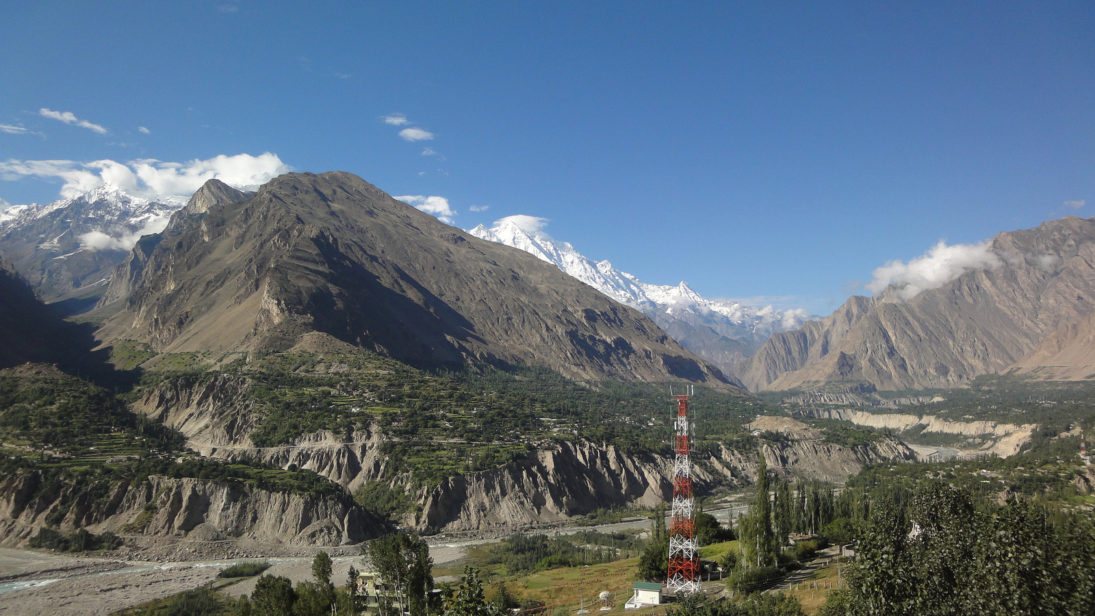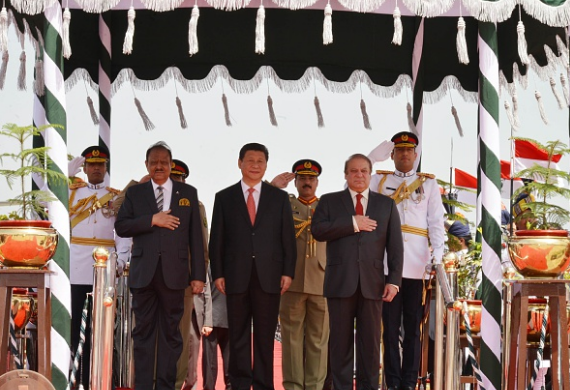
Over a hundred Chinese trucks loaded with goods rolled into the Sust dry port in Gilgit Baltistan (GB) in the last week of October en route Gwadar Port, as part of the first trade activity of the now at least $51 billion worth China-Pakistan Economic Corridor (CPEC) project. Hailed as a game-changer, the project envisions a network of roads, railways, and pipelines crisscrossing the approximately 3000-km long route commencing from the Karakoram Highway in GB and linking China’s northwestern Xinxiang province with Pakistan’s southern port of Gwadar—its gateway to the world and beyond. The shipment proceeded to the Gwadar Port where it was loaded onto Chinese ships already docked and ready for departure to the Middle East and Africa. As the cargo left Pakistani shores in mid-November, it marked the formal operationalization of CPEC.
Part of its One Road One Belt vision, CPEC provides shorter trade connectivity to China while allowing it to circumvent the contentious Strait of Malacca. It also provides China easy access to the oil-rich Persian Gulf – China’s main source of energy security. CPEC further augments China’s domestic objectives. It is envisaged as a precursor to the development of its relatively underdeveloped northeastern region, also marred by instability, especially the Uighur-driven dissent in Xinjiang province. CPEC is intended to galvanize the region economically, neutralize political fault lines, while making way for smoother outreach to bordering Central Asia.
No such change of fortune, however, awaits GB, the fulcrum of the project on the Pakistani side. If anything, the region’s exclusion from the fruits of the project adds to the sense of deprivation gestating within the region. A much endowed region, it has abundant natural resources such as copper, iron, gold, and silver along with reserves of Uranium 238. It is also home to the largest glaciers outside the polar region providing access to precious fresh water reserves. The region’s snow-covered peaks and heavy precipitation also contribute substantially to the flow of the Indus River basin – the backbone of Pakistan’s water-intensive agricultural economy. GB has the potential to produce nearly 50,000 MW of (clean) hydroelectric energy, however it remains largely untapped.
At the core of the region’s dilemma lies its unresolved constitutional status. Part of the erstwhile princely state of Jammu and Kashmir (J&K), it acquired its separation from the then political dispensation through a revolt in November 1947. The disputed nature of the territory however persists, as part of the broader Kashmir issue. Under the controversial Karachi Agreement of 1949, which was signed between the Government of Pakistan and that of Pakistan-administered Kashmir, the region was constitutionally placed under the administrative control of Pakistan. Certain reforms towards devolution of powers were introduced in the 1970s and 2009, but they failed to assuage either public sentiment or legal quandary. In the meantime, demands for a more substantive constitutional status sharpened within GB, especially for its assimilation with Pakistan as its fifth province. The demand was however contested by Kashmiri nationalist parties, such as native Amanullah Khan’s Jammu and Kashmir Liberation Front, within GB and other parts of J&K. The demand also posed a challenge to Pakistan’s broader Kashmir policy. It would also impact the dynamics of the Kashmir issue more critically. A formal assimilation of GB within Pakistan’s constitutional framework would be a contravention of international law and the United Nations resolutions of 1949 on Kashmir, but more significantly it could set a precedent for India to replicate the same in the part of Kashmir under its administration.

These strategic constraints not only held the region back from materializing its huge potential but also steered Pakistan towards administratively separating GB from Pakistan-administrated Kashmir, in a bid to de-link it from the larger Kashmir issue. Given its strategic location bordering China and the Wakhan Corridor of Afghanistan, adjacent to Central Asia (key to the erstwhile Silk Road) while also home to the Siachen Glacier, the GB region has acquired crucial significance for Pakistan’s strategic and security interests.
Within the milieu of CPEC, politico-legal complexities have manifested simmering disenchantment within the region. Despite being the central gateway for CPEC, GB has been left out of the projected benefits of the project. After several assurances of the allotment of economic zones in GB at par with allocations for other provinces along the CPEC route, their non-existence was finally confirmed by a high-level Pakistani Senate delegation visiting the region in mid-August. In fact, GB was left out of the National Parliamentary meet called to deliberate upon the broader aspects of CPEC in November 2015. Such exclusions have fanned a growing sense of neglect and discrimination against the region. The arrest of local rights activist Baba Jan under the Anti Terrorism Act had already left the region in disquiet. It has since witnessed a spurt in strikes and sit-ins organized by the Awami Action Committee – an umbrella organization of 23 regional parties—to condemn the lack of share in the CPEC-associated development projects. In the face of rising discontent, Islamabad yet again announced a slew of projects in September, as usual sans the requisite spadework on the ground.
The region also fears a demographic shift. Despite its vast expanse of land, only a minuscule proportion is cultivable. It is feared that the influx of wealthy investors could overrun the land while offering little in return, leaving the locals further violated. This has triggered a debate for reintroduction of the State Subject rule abrogated in 1974–that law safeguarded the rights of the indigenous people over their land and way of living.
Envisaged as an international trading and logistics hub, it is imperative that CPEC strike a fructifying trade-off with GB, delivering a more two-way process of benefits. Failure to do so could choke off the very lifeline of the project, right at its gateway.
***
Image 1: Martin Loetzsch, Flickr


